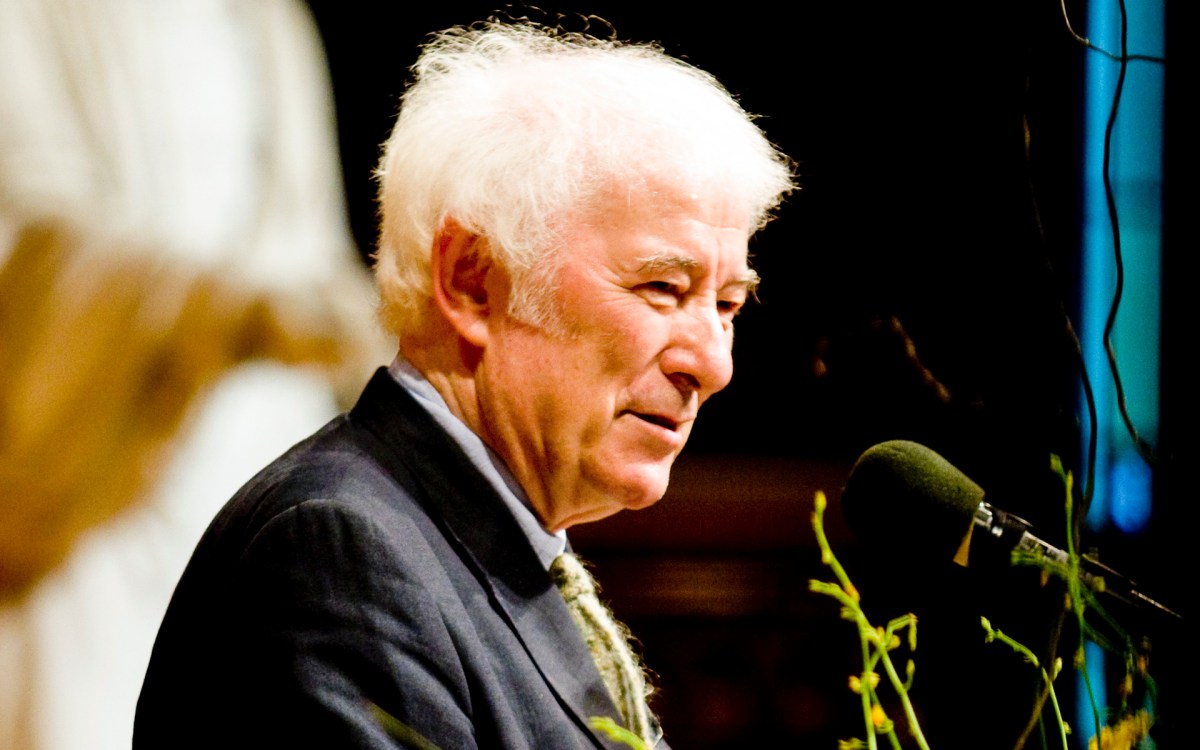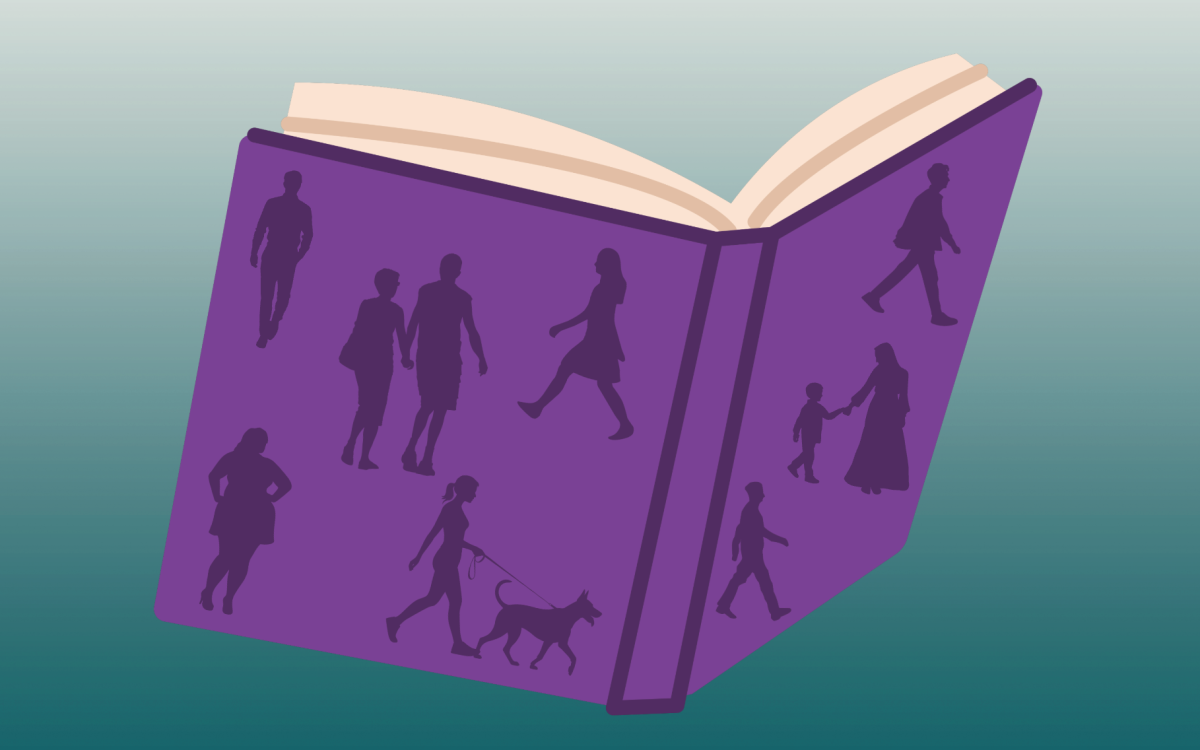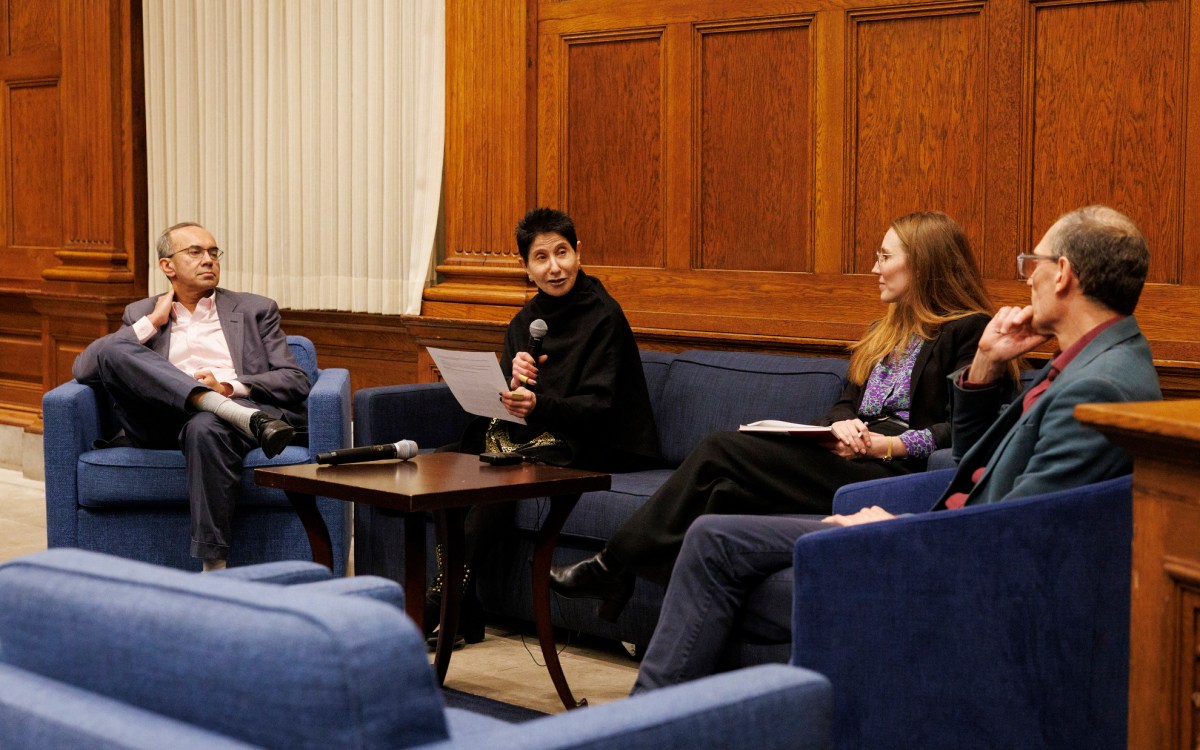Reading like it’s 1989

Illustration by Liz Zonarich/Harvard Staff
Report on classroom literature shows staying power for ‘Gatsby,’ ‘Of Mice and Men,’ other classics. Time to move on?
Look back 40 years and you’ll see a lot of seismic change. The rise of the Internet, the smartphone revolution, and now AI everywhere. The end of the Cold War and the dawn of many messier conflicts. The overturning of paradigms of gender and sexuality, and then the backlash.
What are young people reading to help them make sense of their world? According to a recent report, pretty much the same things their parents read.
That report — compiled by researchers Kyungae Chae and Ricki Ginsberg for the National Council of Teachers of English — queried more than 4,000 public school teachers in the U.S. about what they assign students in grades six through 12.
It found little movement at the top of the English curriculum. F. Scott Fitzgerald’s “The Great Gatsby,” John Steinbeck’s “Of Mice and Men,” and a few Shakespeare tragedies occupy half of the top 10 most-assigned spots — just as they did in 1989. Even back in 1964, the top 10 was remarkably similar: If two Dickens novels have been dropped, “Hamlet” and “Macbeth” have not.
Classics are “classic” for a reason, of course. But that English-class inertia coincides with a trend that troubles educators, authors, and many parents: a long-term slide in the habit of reading among young Americans.
Some worry that — in a diverse and polarized nation — books that once felt accessible now feel remote or impenetrable, or that cultural conservatism or education bureaucracies have kept the curriculum from a healthy evolution.
With their many avid readers, Harvard’s classrooms contain almost as many views of the problem, if it is one, of curricular stagnation.
Stephanie Burt, the Donald P. and Katherine B. Loker Professor in the Department of English, made headlines last year as she launched a course on Taylor Swift. It was, in part, a self-conscious bid to use the world’s most popular songwriter as a gateway drug to Wordsworth and hermeneutics.
But Burt — also a working poet — said that her embrace of Swift is no sign that she has moved beyond, say, John Donne. To teach Shakespeare to young people, she said, is “not conservatism — it’s conservation, like the protection of old-growth forests.”
Rosette Cirillo, too, sees pedagogical value in true classics from the top of the English-language pantheon — though for a different reason.
Today, Cirillo is a lecturer and a teacher educator at the Harvard Graduate School of Education. But not so long ago, she was teaching eighth-grade English in Chelsea, Massachusetts, a largely Latin-American enclave where nearly half the students are classed as English learners.
“If I had an eighth-grader who went on to Harvard after he graduated Chelsea High, and he had never read Shakespeare, he would be at a serious disadvantage,” Cirillo said.
And, she stresses, she’s arguing less in terms of assimilation than of challenge.
“If I don’t understand ‘The Great Gatsby’ — this story of the American dream — and the idea of a masculine reinvention in order to achieve something, then I don’t understand the mythology of America enough that I could critique it, that I can say, ‘I don’t want that,’” Cirillo said. “We’re thinking about building a language and culture of power and building access for our students.”
“Better readers are better at understanding the multiple points of view that might be held about a civic or a moral issue. They’re less likely to think that if you disagree with them, it’s because you’re stupid.”
Catherine Snow
The teachers and researchers who spoke to the Gazette were divided on whether Steinbeck, Fitzgerald, and Harper Lee still deserve their ubiquity.
“To Kill a Mockingbird,” which Lee published in 1960, could be considered the foundational American text of the ‘white savior’ archetype, Burt said. And, yes, Steinbeck was a Nobel laureate in literature, but with “Of Mice and Men” — “the point is that somebody cognitively disabled is probably going to commit a murder … the high school curriculum would be better off without that,” she said.
And while Burt praised “Gatsby” as a great option for many teens, Catherine Snow was less charitable.
“I always hated that book,” she said.
Snow, a legendary literacy researcher, recently retired from the Harvard Graduate School of Education. She argued that hard evidence still shows real benefits that come from building readers.
Not only do well-read people perform better on tests of general knowledge — but as early as elementary school, Snow said, “better readers are better at understanding the multiple points of view that might be held about a civic or a moral issue. They’re less likely to think that if you disagree with them, it’s because you’re stupid … I think that’s pretty important.”
Digesting a text, analyzing tone and symbolism, understanding meaning and perspective — it’s all still useful. But, Snow said, some older books may no longer be ideal teaching tools.
“You can make all of those hoary texts relevant to students today,” Snow said. (True even of “Gatsby,” she joked: “Here’s a chance to learn about some really boring, worthless people, and how badly they’ve screwed up their lives.”)
“But,” Snow added, “an easier and perhaps more efficient approach would be to try to think about a selection of texts which are more automatically relevant that can be used to develop the same very important cognitive and linguistic and analytic skills.”
“Harry Potter” and “The Hunger Games” traffic, too, in “big, inherent, cultural themes and memes,” she said, and neither is “particularly easy reading.”
The cultural phenomena around those two series defied a decadeslong slump in pleasure reading among youth. In light of that trend, Cirillo and others see room to renovate the curriculum in the margins.
For Cirillo, stories by writers of color — from Toni Morrison to Junot Díaz — should by now be standard fare, part of a “new canon” to be read alongside the old one.
Burt’s chief concern, meanwhile, is the smartphone and its iron grip on our attention. “We’re living through a change in media that comes from a change in technology that is — unfortunately — at least half as consequential as the printing press,” Burt said. “I hate it; it makes me sad. But it’s not something we can wish away.”
Burt proposed shelving “Of Mice and Men” in favor of Frederick Douglass’ first autobiography, as “one piece of American prose literally everyone should have to read.”
Whether or not it can be neatly quantified, teachers of English still believe that there is something irreplaceable about profound immersion in the world of a book. Joining their number is M.G. Prezioso, a 2024 Ed School grad now conducting postdoctoral research on that very phenomenon.
In a recent journal article, Prezioso found a cyclical relationship between frequent reading and “story-world absorption” — a virtuous cycle of joy in reading that might lessen the need for external motivators.
And her ongoing research of grade-school students in Massachusetts and Pennsylvania has yielded early but promising correlations between that kind of absorption and skill at reading comprehension of the kind measured by a standardized test.
But that doesn’t mean abandoning what is already taught, Prezioso said. “There tends to be this dichotomy, first of all, between classic, canonical books versus books that are fun, as if canonical books can’t be engaging or dramatic or enjoyable to read.”
Prezioso was reminded of that in her surveys of high school students. What did they find most engrossing? “Harry Potter,” “The Hunger Games,” Edgar Allan Poe — and “Of Mice and Men.”




